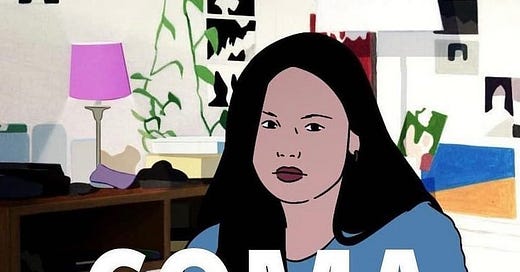For the last few years, I have used October to give myself a viewing assignment: a different horror film each day. Now that I have escaped the real life horror of New Zealand’s public service, I intend to write a piece inspired by each film.
My eighth film is Bertrand Bonello’s Coma (2022).
I have already mentioned Bonello in this newsletter with his (excellent) 2019 film Zombi Child which explores the blowback from French colonialism through Haitian Voodoo. His 2016 opus Nocturama may be my favourite film of that decade, an overwhelming depiction of millennial angst by way of an ostensibly purposeless terrorist attack. This year, his profile is higher than ever for The Beast, a science fiction ‘romance’ between two characters across time.
Coma exists in a sort of limbo (literally and figuratively) between these other works, rounding out a trilogy about youth with his 2016 and 2019 films. It is self-consciously a COVID production, made and set during a lockdown like the one France underwent in 2021. It follows an unnamed teenage girl (Louise Labèque) who experiences crises related to her own sense free-will as she spends her lockdown navigating Zoom calls, YouTube videos and terrifying dreams.
The premise means that Coma has one foot in the ‘screenlife’ tradition of the last decade. Since 2014’s Unfriended, a number of films, usually horror, have been set entirely on a computer screen. It’s like found footage if the device was tethered in one place. I love a cinematic gimmick done well and films like Host (2020, another COVID production) show how effective this can be as a narrative device. Of course there are other films that struggle to sustain the gimmick like 2018’s (regrettable) Searching which pans and scans around the frame, terrified that the audience will miss an important detail.
Although Coma doesn’t entirely take place on a computer screen, its frame is extremely important. It alternates between aspect ratios as it switches gimmicks using a (wider) 1.78 : 1 ratio for its ‘screenlife’ portions and a (more constrained) 1.33 : 1 ratio when it returns to ‘real life’. The best point of comparison is Jane Schoenbrun’s We’re All Going to the World’s Fair (2021) which is also focused on a single teenager navigating the online world and ‘real life’ as the distinction becomes increasingly blurred. Like Schoenbrun’s film, it gestures towards horror without ever letting itself fall into genre traps (so forgive me for including it in my viewing for the month).
Although Labèque is in nearly every scene, the second most important character is the figure she spends the film engaging with, streamer Patricia Coma (Julia Faure). Coma is at once a weather presenter, beauty influencer, philosopher, agony aunt and psychopomp. On her channel she promotes a device called a ‘revelator’, a sort of fidget cube that can be played as an unloseable game. This constant positive reinforcement could be a hacky comment on the impact of online life on young brains but Bonello takes it a step further into a treatise on the nature of free will.
If the girl is incapable of losing the game of the revelator does she have free will? If she can’t leave her room (in the world of the film it’s a climate change-induced heatwave, not COVID that prompted the lockdown), does she have free will? Maybe she has free will in the world of her dreams?
As fatalistic as this may sound, the film does not come down in favour of determinism. The girl’s lockdown experience is bookended by messages from Bonello to his daughter Anna in which he challenges her to make her own future beyond the immediate lockdown. In his prologue he says: “Take your time, do not surrender to the current mood. That will be your liberty… even if winter is long and harsh, spring always returns. And that’s why we keep going. Because there’s always rebirth. Nocturama, which was dedicated to you, may have seemed full of despair, but it too carried this rebirth within it.”
The helplessness of lockdown is a relable feeling. For some people it was comforting, for others it was suffocating, in any case it resulted in a kind of ‘unreality’, even insanity. For this reason, I think Coma captures the vibe of lockdown impeccably. Not just the narrow confines of ‘screenlife’ but a collage in which Coma’s videos sit alongside other video formats. These include Zoom calls in which the girl and her friends discuss the hottest serial killers, hand-drawn interludes and a sort of TV show featuring the girl’s dolls. In these latter sequences, the dolls act out sitcom plots, repeat lines from Coma and even recite Donald Trump tweets. The use of verbatim right-wing diatribes works better here than it did in The Beast where large portions of the film were given over to on-the-nose quotes from an incel manifesto.
Coma is an odd film but, for the way it gets this balance between empowerment and despair, it is the most effective depiction of lockdown I’ve seen.







